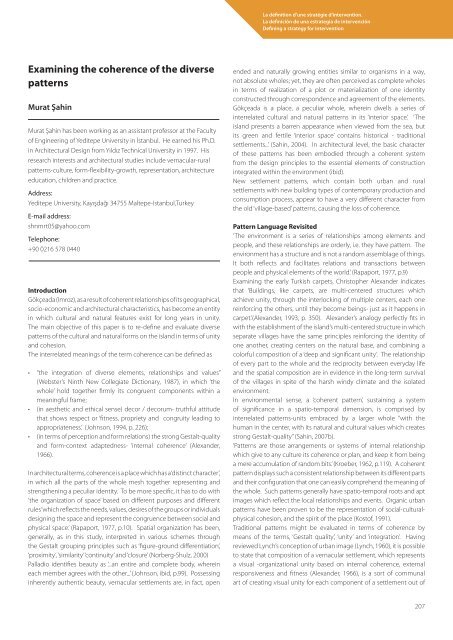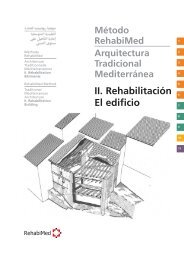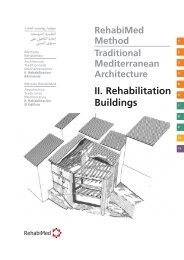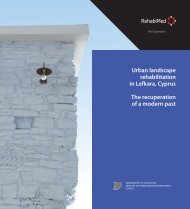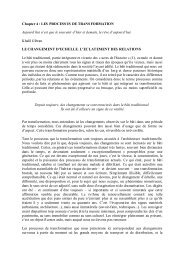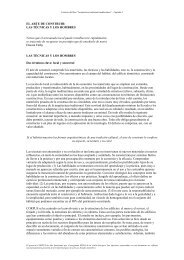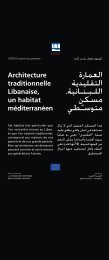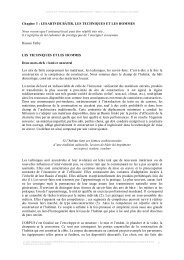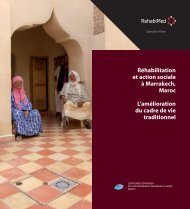La définition d'une stratégie d'intervention. La ... - RehabiMed
La définition d'une stratégie d'intervention. La ... - RehabiMed
La définition d'une stratégie d'intervention. La ... - RehabiMed
You also want an ePaper? Increase the reach of your titles
YUMPU automatically turns print PDFs into web optimized ePapers that Google loves.
<strong>La</strong> <strong>définition</strong> d’une <strong>stratégie</strong> d’intervention.<br />
<strong>La</strong> definición de una estrategia de intervención<br />
Defining a strategy for intervention<br />
Examining the coherence of the diverse<br />
patterns<br />
Murat Şahin<br />
Murat Şahin has been working as an assistant professor at the Faculty<br />
of Engineering of Yeditepe University in İstanbul. He earned his Ph.D.<br />
in Architectural Design from Yıldız Technical University in 1997. His<br />
research interests and architectural studies include vernacular-rural<br />
<br />
education, children and practice.<br />
Address:<br />
Yeditepe University, Kayışdağı 34755 Maltepe-Istanbul,Turkey<br />
E-mail address:<br />
shnmrt05@yahoo.com<br />
Telephone:<br />
+90 0216 578 0440<br />
Introduction<br />
Gökçeada (Imroz), as a result of coherent relationships of its geographical,<br />
socio-economic and architectural characteristics, has become an entity<br />
in which cultural and natural features exist for long years in unity.<br />
The main objective of this paper is to re-define and evaluate diverse<br />
patterns of the cultural and natural forms on the island in terms of unity<br />
and cohesion.<br />
The interrelated meanings of the term coherence can be defined as<br />
<br />
<br />
<br />
<br />
(Webster’s Ninth New Collegiate Dictionary, 1987), in which ‘the<br />
whole’ hold together firmly its congruent components within a<br />
meaningful frame;<br />
<br />
that shows respect or ‘fitness, propriety and congruity leading to<br />
appropriateness.’ (Johnson, 1994, p. 226);<br />
<br />
and form-context adaptedness- ‘internal coherence’ (Alexander,<br />
1966).<br />
In architectural terms, coherence is a place which has a ‘distinct character’,<br />
in which all the parts of the whole mesh together representing and<br />
strengthening a peculiar identity. To be more specific, it has to do with<br />
‘the organization of space’ based on different purposes and different<br />
<br />
designing the space and represent the congruence between social and<br />
physical space.’ (Rapaport, 1977, p.10). Spatial organization has been,<br />
generally, as in this study, interpreted in various schemes through<br />
the Gestalt grouping principles such as ‘figure-ground differentiation’,<br />
‘proximity’, ‘similarity’ ‘continuity’ and ‘closure’ (Norberg-Shulz, 2000)<br />
Palladio identifies beauty as ‘...an entire and complete body, wherein<br />
each member agrees with the other...’ (Johnson, ibid, p.99). Possessing<br />
inherently authentic beauty, vernacular settlements are, in fact, open<br />
ended and naturally growing entities similar to organisms in a way,<br />
not absolute wholes; yet, they are often perceived as complete wholes<br />
in terms of realization of a plot or materialization of one identity<br />
constructed through correspondence and agreement of the elements.<br />
Gökçeada is a place, a peculiar whole, wherein dwells a series of<br />
interrelated cultural and natural patterns in its ‘interior space’. ‘The<br />
island presents a barren appearance when viewed from the sea, but<br />
its green and fertile ‘interior space’ contains historical - traditional<br />
settlements...’ (Sahin, 2004). In architectural level, the basic character<br />
of these patterns has been embodied through a coherent system<br />
from the design principles to the essential elements of construction<br />
integrated within the environment (ibid).<br />
New settlement patterns, which contain both urban and rural<br />
settlements with new building types of contemporary production and<br />
consumption process, appear to have a very different character from<br />
the old ‘village-based’ patterns, causing the loss of coherence.<br />
Pattern <strong>La</strong>nguage Revisited<br />
‘The environment is a series of relationships among elements and<br />
people, and these relationships are orderly, i.e. they have pattern. The<br />
environment has a structure and is not a random assemblage of things.<br />
<br />
people and physical elements of the world.’ (Rapaport, 1977, p.9)<br />
Examining the early Turkish carpets, Christopher Alexander indicates<br />
that ‘Buildings, like carpets, are multi-centered structures which<br />
achieve unity, through the interlocking of multiple centers, each one<br />
reinforcing the others, until they become beings- just as it happens in<br />
carpet.’(Alexander, 1993, p. 350). Alexander’s analogy perfectly fits in<br />
with the establishment of the island’s multi-centered structure in which<br />
separate villages have the same principles reinforcing the identity of<br />
one another, creating centers on the natural base, and combining a<br />
colorful composition of a ‘deep and significant unity’. The relationship<br />
of every part to the whole and the reciprocity between everyday life<br />
and the spatial composition are in evidence in the long-term survival<br />
of the villages in spite of the harsh windy climate and the isolated<br />
environment.<br />
In environmental sense, a ‘coherent pattern’, sustaining a system<br />
of significance in a spatio-temporal dimension, is comprised by<br />
interrelated patterns-units embraced by a larger whole “with the<br />
human in the center, with its natural and cultural values which creates<br />
strong Gestalt-quality” (Sahin, 2007b).<br />
‘Patterns are those arrangements or systems of internal relationship<br />
which give to any culture its coherence or plan, and keep it from being<br />
a mere accumulation of random bits.’ (Kroeber, 1962, p.119). A coherent<br />
pattern displays such a consistent relationship between its different parts<br />
and their configuration that one can easily comprehend the meaning of<br />
the whole. Such patterns generally have spatio-temporal roots and apt<br />
<br />
patterns have been proven to be the representation of social-culturalphysical<br />
cohesion, and the spirit of the place (Kostof, 1991).<br />
Traditional patterns might be evaluated in terms of coherence by<br />
means of the terms, ‘Gestalt quality’, ‘unity’ and ‘integration’. Having<br />
reviewed Lynch’s conception of urban image (Lynch, 1960), it is possible<br />
to state that composition of a vernacular settlement, which represents<br />
a visual -organizational unity based on internal coherence, external<br />
responsiveness and fitness (Alexander, 1966), is a sort of communal<br />
art of creating visual unity for each component of a settlement out of<br />
207


